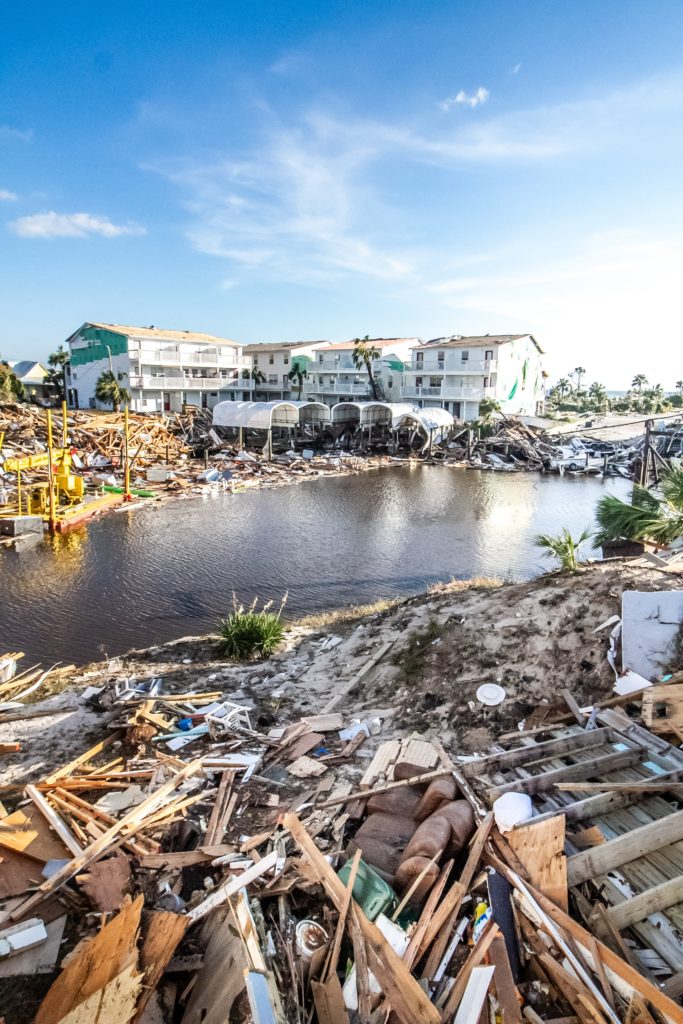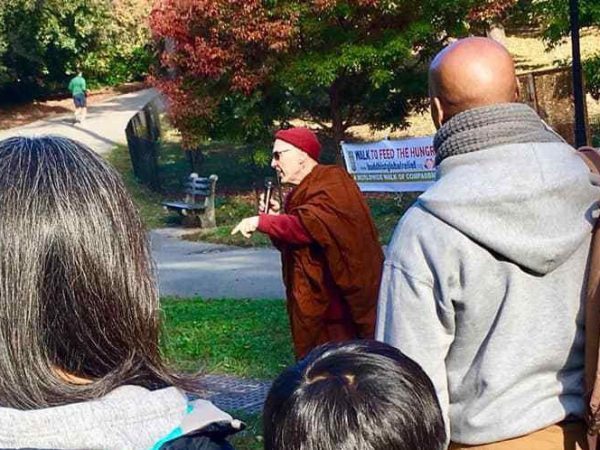The following Dharma principles directly apply to the issue of climate disruption:
- Reverence for life: From this point forward climate disruption is the overriding context for all life on earth, including humans. What we humans do will determine what life survives and thrives and in what form and locations.
- Happiness stems from helping others: Our greatest personal happiness comes when we give of ourselves and help others. For example, many people instinctually help our neighbors after a natural disaster, which indicates that altruism and the desire to help others is built unto our genes. We must grow and apply this to the marginalized among us that are at least initially hit hardest by climate disruption. This is the very opposite of the greed and self-centeredness that dominates today.

- We suffer when we cling: The very nature of happiness is dependent on our capacity to give up our attachments and help others. This same principle must now be elevated and applied to public policies of all types.
- The ethical imperative: All beings matter. We should act in ways that are beneficial for both self and others, acting out of a commitment to altruism and compassion for others.
- Interconnection and interdependence: We must dissolve objectification of other people and nature and overcome the belief in a separate self that leads us to through a sense of kinship. Even as we let go of the delusion of an individual self that is separate from other people, we must let go of the delusion that humanity is separate from the rest of the biosphere. Our interdependence with the earth means that we cannot pursue our own well-being at the cost of its well-being. When the earth’s ecosystems become sick, so do our bodies and our societies.
- Renunciation, simplicity: To resolve climate disruption we must be willing to renounce attachments to things to contribute to the problem and live more simply.
- The relationship between the First and Second Noble Truth and capacity to learn to work with difficult states: Understanding the suffering we have created symbolized by climate disruption and how it came about and that we can learn not to identify with it and instead work through distressing states such as fear, despair, etc.
- Opening to suffering as a vehicle for awakening: The suffering caused by climate disruption provides an unprecedented opportunity for humans to learn from our individual and collective mistakes and manifest a great awakening. It is a special opportunity like never before. We can find ways to be happy—we can “tend and befriend” rather than fight (among ourselves), flee, or freeze. We can acknowledge that this is the way things are now, open to the suffering rather than becoming attached, and think and act in new ways.

- The interconnectedness of inner and outer, the individual and the collective (or institutional): Climate disruption provides an unprecedented opportunity to understand the roots of the problem—which relate to the ways our minds work and how those patterns become embedded in collective and collective/ institutional practices and policies. This awareness can open the door to new ways of thinking and responding that will eventually produce different institutional practices and policies.
- Connection to diversity and justice issues. The Dharma principles and narratives must also apply to issues or diversity and social inclusion and justice. The beliefs in separateness etc that has produced the climate crisis also leads to social inequity and exclusion. People of color and other marginalized groups must be included.
- Buddhism as a social change agent: The principles of Buddhism help us engage with life, not remove ourselves from it. The Buddha was actively engaged with his social and cultural contexts and for Buddhism to have relevance today it must help people understand how to engage in today’s political and social contexts.
- Adhitthana or determination: We are called to develop resolve, determination, and heroic effort now. We must have the courage to realize that we are being called to engage in this issue and that living the Dharma will see us through the hard times.
- This precious human birth is an opportunity: We must always remember that it is a rare and precious thing to be born as a human and we have been given a rare opportunity to act as stewards because humans are not only the source of destruction—we are also a source of great goodness.
- Love is the greatest motivator: Our deepest and most powerful action comes out of love: of this earth, of each other. The more people can connect with and feel love for the Earth, the greater the likelihood that their hearts will be moved to help prevent harm. Children should therefore be a top priority. Need to help people realize what they love about life and what will be lost as climate disruption increases.

- The sangha—and other forms of social support–are essential: The reality of climate disruption is a profound shock to many people and the only way to minimize or prevent fight, flight, freeze responses is to be supported by and work with others so people will not feel alone, can overcome despair, and develop solutions together. We need to go through this journey together, sharing our difficult reactions and positive experiences in groups and communities.
- The Bodhisattva: The figure of the Bodhisattva which is a unifying image of someone who is dedicated to cultivating the inner depths and to helping others, is an inspiring figure for our times.
What Followers of the Dharma Can Do In Body, Speech and Mind
To effectively respond to this call to action, followers of the Dharma can hold a vision of a world that is not moving towards destruction, a world that is sustainable, a world that is powered by clean energy, no longer burning fossil fuels, a world where poverty is eradicated, population growth is stabilized and natural systems – oceans, forests, soil, etc. – are restored. We can speak about our love for the natural world, children and animals, and how solving the problem of climate change is essential for their future. When there is talk of unusual weather, storms, droughts, floods, fires, increased food insecurity, spread of hunger, water shortages, spread of tropical diseases, and so on, we can point out that climate change is the primary cause.
We can inform ourselves by reading a few key articles like Global Warming’s Terrifying New Math by Bill McKibben or Our Society Is Living a Massive Lie About the Threat of Climate Change — It’s Time to Wake Up by Margaret Klein or by watching the “Do the Math” movie. We can also get together with friends to read and discuss landmark books like Eaarth by Bill McKibben and World on the Edge by Lester Brown. We can connect with a group like 350.org that is consistently telling the truth about climate change and organizing events that move our social and political systems towards solutions and participate in those events. When we come together to celebrate our love for the natural world and the beings that inhabit it, speak the truth about climate change, and take a stand to turn the forces that threaten our climate, we reclaim our own inner stability and strength and live closer to the truth and therefore closer to the Dharma.
About the Authors
The Dharma Teachers International Collaborative on Climate Change was a group of Buddhist teachers that sought to inspire Buddhist and laypeople alike to engage in solutions to the climate crisis by sharing the wisdom found in the Dharma. The group was coordinated by The Resource Innovation Group under the direction of Bob Dopelt.
The collaborative began at the Vipassana meditation teachers annual global conference in June 2013 at Spirit Rock Meditation Center in California. For the first time at one of the annual meetings, a session was held on climate change. Out of that discussion a group of 25 Vipassana teachers from South Africa, Europe, Canada and the U.S. began to work together to discuss how the Dharma can help inspire Buddhist and non-Buddhists alike to engage in solutions to the climate crisis. Although the first members of the collaborative, listed below, were primarily Vipassana teachers, the group welcomed the involvement of teachers from all Buddhist lineages.
- Martin Aylward, Moulin de Chaves Retreat Centre, France
- Steve Armstrong, Vipassana Metta Foundation and Kamala Masters, U.S.
- Pascal Auclair, Voie boréale, True North Insight, Canada
- James Baraz, Spirit Rock, U.S.
- Ven. Bhikkhu Bodhi, Chuang Yen Monastery, U.S.
- Tara Brach, Insight Meditation Community of Washington, U.S.
- Grove Burnett, Vallecitos Mountain Ranch, U.S.
- Mark Coleman, Spirit Rock, U.S.
- Chas DiCapua, Insight Meditation Society, U.S.
- Trudy Goodman, InsightLA, U.S.
- Ruth King, Insight Meditation Community of Washington and Mindful Members of Charlotte, U.S.
- Gregory Kramer, Metta Foundation, U.S.
- Kirsten Kratz, Gaia House, U.K.
- Stefan Lang, Zentrum für Buddhismus, Switzerland
- David Loy, Sanbo Kyodan, U.S.
- Catherine McGee, Gaia House, UK
- Wes Nisker, Spirit Rock, U.S.
- Adrianne Ross, B.C. Insight Meditation Society, Canada
- Donald Rothberg, Spirit Rock and East Bay Meditation Center, U.S.
- Ayya Santussika, Karuna Buddhist Vihara, U.S.
- Ayya Santacitta, Aloka Vihara, Austria and U.S.
- Renate Seifarth, Insight Meditation, Germany
- Amma Thanasanti, Awakening Truth, Shakti Vihara, U.S.
- Pamela Weiss, Spirit Rock, U.S.
- Thanissara Weinberg, Chattanooga Insight, U.S. and Dharmagiri South Africa
- Kittisaro Weinberg, Chattanooga Insight, U.S. and Dharmagiri South Africa
- Arianna Weisman, Insight Meditation Center of the Pioneer Valley, U.S.
- Diana Winston, UCLA Mindful Awareness Research Center and Spirit Rock, U.S.






